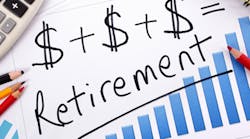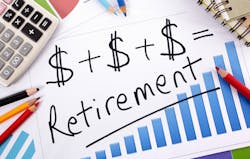How much money do you need to retire from your dental practice?
I gave a presentation to a large group of dentists at a state convention this spring. After I finished, a few dentists came up to chat. I couldn’t help but smile because they all had more or less the same question. Not surprisingly, it was also the most commonly asked question at our booth:
"How much money do I need to save before I can retire?"
It’s the golden question everyone seems to be asking, and the answer is surprisingly simple. But to get it right, you first need to understand one thing.
Most people tend to just estimate a retirement budget, but that doesn’t work because it relies too heavily on memory. This method also doesn’t take into account large, irregular expenses, such as vacation spending, vehicle purchases, and other lifestyle expenses. We recommend factoring an average of your spending over a three-year period to give you an accurate and true measure of a comfortable lifestyle, based on how much money you actually spend.
Today’s spending vs. tomorrow’s spending
With my own retirement planning, I don’t make complicated guesses about how much less I think I can live on in the future. I simply assume I’m going to spend a similar amount of money down the road as I’m spending today. Your expenses will transform over time, but they won’t drop as much as you might think.
For example, costs for kids become costs for grandkids (flights to see them, gifts, or college assistance). Your mortgage payment is replaced with expenses for a new roof, significant remodeling, or maybe even a second home. Your student loan payment becomes increased health care costs.
Simply stated, it’s more reasonable to plan for the future based on what you’re currently spending. This is how you should ideally envision retirement—less financial pressure, more flexibility, a personal legacy, and true independence. Why would you shoot for anything less? It’s true that some costs decrease as you age, but if you plan for your post-retirement spending to be similar to your pre-retirement spending, you’ll have a little more flexibility and peace of mind.
Tracking your spending with technology
The good news is that technology makes it easy to track your spending. You can connect all of your accounts, and your spending will automatically be tracked without you having to lift a finger. You can use tools such as mint.com, or you can commission someone to do it for you using a collaborative tool such as eMoney Advisor.
As you earn more and spend more, it becomes difficult to track everything and make an accurate prediction. That's where a competent financial advisor can make a difference in helping you prepare for your future. A simple miscalculation of $500 per month can affect your retirement projection by hundreds of thousands of dollars. A miscalculation of plus or minus a few thousand dollars per month (which is common among business owners) can affect your retirement goals by millions.
When it comes to predicting your financial needs in retirement, guesses make messes. If you track your spending over a three- to five-year period and categorize each expense in an organized way, you’ll get a good handle on how you spend money on food, vehicles, clothing, entertainment, vacations, and more. You’ll know how much money you spend annually and on what, so you can be absolutely sure you’re improving, or at least maintaining, your standard of living in retirement.
The golden question: How much money do I need?
Now that you know your future spending will be similar to your current spending, you can calculate how much money you’ll need to retire. Here’s my best shot at making this simple for dentists—you will need somewhere between 20 to 30 times your annual spending. The older you are, the lower you can go on this spectrum. The younger you are, the higher you’ll need to go on the spectrum.
That’s easy enough, right? Just take what you spend annually and multiply it by 30. This figure will represent how much money you need for an uber-successful retirement portfolio. Here’s what I mean by portfolio—your portfolio is the total of all your assets, excluding the equity in your primary residence. We don’t count the equity in your home because most people don’t want to have debt on their house when they retire. Sometimes we must count home equity if someone can’t retire without tapping into it, but that’s not the ideal situation.
To determine the sum of your portfolio, add up all your cash, investments, practice real estate equity, and practice equity. For example, $100k cash/investments + $500k practice equity + $400k real estate equity = $1M.
Next, divide it by how much money you spend each year. If you spend $100,000 per year, then your portfolio is 10 times your annual spending, because $1M / $100k = 10. In other words, you could live off the funds in your portfolio for 10 years. We call this number your Total Term, or Tt™. So what’s your Total Term? Are you on the way to hitting 30, or have you been stuck at 10 for 10 years?
Where are you on your path to retirement?
I often ask my team, “What is Dr. X’s Total Term? What was it last year? How much progress is he making each quarter?” We measure someone’s overall retirement health based on this metric. If someone moves ahead one year for every year they work, we call this a 1:1 client. Some dentists are 2:1 clients, meaning they get ahead two years for every one year they work. It’s an important indicator that we monitor, and it should be important to you.
Some dentists in the latter stages of their career are 3:1 or even higher, especially if their investments experience periods of large growth. Of course some dentists experience really difficult years where they move backwards. This can happen when your investments decline in value, or when you take on a lot of debt for equipment or tenant improvements. It shouldn’t happen often, but when it does you should know why.
Conclusion
One of the biggest challenges to financial planning is defining your goal. Your portfolio (cash, investments, practice equity, non-residence real estate equity) needs to be 30 times your annual spending in order to retire comfortably. Keep this target in mind and you will get there.
This is challenging, but dentists are in a profession where they CAN accumulate 30 times their annual spending. Even GPs in tough and competitive markets can earn enough to make this happen if they start early, watch their personal spending, and plan carefully.
About the Author

Reese Harper, CFP
Founder and CEO, Dentist Advisors
Reese Harper is host of the Dentist Money Show, a weekly podcast dedicated to helping dentists make smart financial decisions. He is also founder and CEO of DentistAdvisors.com, a registered investment advisory firm which focuses exclusively on dentists and specialists. His trademarked planning methodology called Elements is used by dentists all over the country to plan, invest, and retire better.
Updated April 8, 2017


